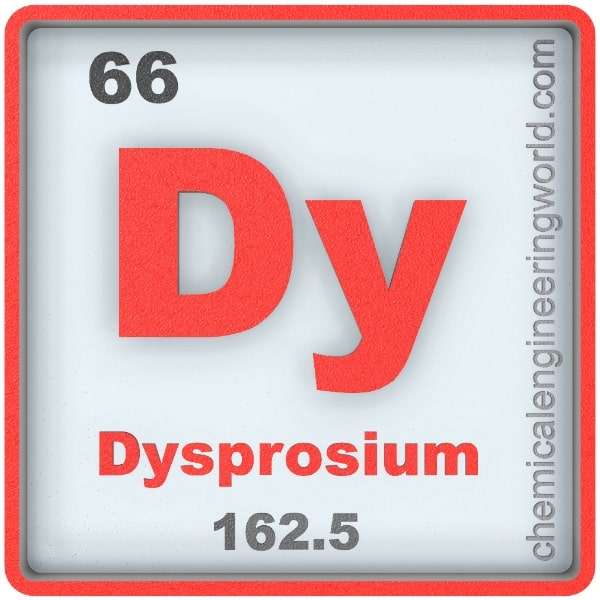Dysprosium Element Properties and Information

Dysprosium Element Properties and Information
Dysprosium is 66th element on the periodic table. Elements are arranged in the periodic table on the basis of the atomic number. Atomic number is the number of protons in the nucleus of the atom. Dysprosium has an atomic number of 66. It is located in the Group ‘Lanthanides’ and Period 6 of the periodic table of elements. It is denoted by ‘Dy’. Its name is derived from the Greek word ‘dysprositos’ meaning ‘hard to get’.
Yttrium oxide was made for the first time in 1794, as the time passed it was noted that it contains more new kind of elements. As the result of research put into it, Erbium was extracted in 1843, then holmium in 1878. Paul-Émile Lecoq de Boisbaudran extracted Dysprosium in 1886 from the sample of yttrium oxide. Pure samples of lanthanides were possible to be obtained only after development of ion-exchange chromatography by Spedding et al. in the 1950s. Now a days, liquid-liquid extraction has superseded ion-exchange method to separate many lanthanides.
The concentration of dysprosium in Earth’s crust is 5.2 ppm. It is never found in nature as a pure element, always found combined with other elements. No dysprosium-dominant mineral is known as of yet, it is usually obtained along with other lanthanides from the minerals bastnaesite and monazite. It is found in trace amounts in other minerals as well such as euxenite, fregusonite, xenotime, and gadolinite.
Physical Properties
- Dysprosium has a bright silver metallic luster; its physical characteristics are greatly affected by even small amounts of impurities.
- The atomic mass of dysprosium is 162.5.
- The melting point of dysprosium is 1412 °C.
- The boiling point of dysprosium is 2562 °C.
- The density of dysprosium is 8600 in S.I. units at 20°C.
- Below 85K, dysprosium possesses a simple ferromagnetic ordering. Between 85-179K, the ordering changes to that of helical-antiferromagnetism. Above 179K, dysprosium displays a disordered anti-ferromagnetic ordering.
- Naturally occurring dysprosium are considered to possess 7 stable isotopes; dysprosium-156, dysprosium-158, dysprosium-160, dysprosium-161, dysprosium-162, dysprosium-163, and dysprosium-164.
Chemical Properties
- Dysprosium retains its luster in dry air; however it tarnishes quickly in moist air.
- Dysprosium burns readily in air to form dysprosium(III) oxide.
- Dysprosium is quite electropositive in nature; it reacts slowly with cold-water and faster with hot-water in-order to form dysprosium hydroxide.
- Dysprosium metal reacts with all halogens above the temperature of 200°C to form the corresponding trihalides.
- Dysprosium combines with various non-metals such as nitrogen, phosphorus, carbon, sulfur, and barium, at high-temperatures to form binary compounds.
Methods of Production
From Monazite-sand: Dysprosium is obtained world wide as a by-product of yttrium extraction. Most of the unwanted metals are removed by magnetic separation steps and by flotation process. The dysprosium is then separated from other elements using ion-exchange process. The dysprosium ions are then reacted either with chlorine or fluorine to obtain the dysprosium either in the form of trichloride or trifluoride. Reduction with either calcium or lithium metal yields metallic dysprosium.
Relevance in Chemical and Related Industries
Alloy: Dysprosium is one of the main components used to make magnetostrictive alloys. Magnetostriction is the property of magnetic materials that causes them to change their shape or dimension during the process of magnetization.
Relevance in Other Industries
- Lasers: Dysprosium is one of the ingredients which go in process of making lasers and other lighting materials.
- Nuclear application: Dysprosium has high thermal neutron capture cross-section hence they are used in control-rods in nuclear reactors.
- Detection: Dysprosium is used to measure dose uptake of external ionizing radiation.
- Refrigerators: Dysprosium gallium garnet (DDG), dysprosium aluminum garnet (DAG), and dysprosium iron garnet (DyIG) are used in adiabatic demagnetization refrigeration.
Health Effects on Exposure
Toxicity: Insoluble dysprosium salts are non-toxic. Soluble dysprosium salts are mildly toxic, ingestion of about 500 grams of this material puts a person’s life at risk.
Effects on Surroundings
Dysprosium does not pose any harm to plants, animals, and environment.
References:
https://en.wikipedia.org/wiki/Dysprosium
https://www.lenntech.com/periodic/elements/dy.htm
































